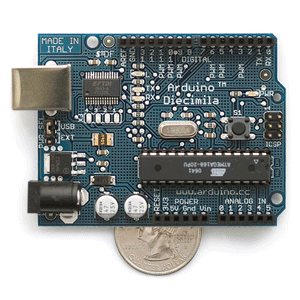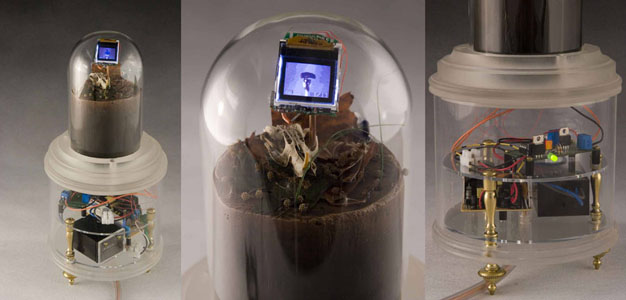Embedded Systems and Kinetic Art
Links
- This is the Arduino Project homepage
- This is the Arduino playground, a wiki for Arduino users
- The Freeduino site has a lot of info from non-official Arduino users
- Slides from F2009 class
- Additional Slides:
- LED Drivers - we have a few chips that you can use to drive multiple LEDs. These chips all have serial (2-4 wire interfaces) to the Arduino so you can send serial LED info and drive a bunch of LEDs. The data sheets are linked below:
- 74HC595 Shift Register with ouput latch
- STP08DP05 8-bit constant current LED driver
- MC14489 5-digit 7-segment LED driver (also 20 individual LEDs)
- MAX 7219 8-digit 7-segment, or 8x8 (64) LED matrix driver
- TLC5940 16-bit constant current LED driver with 4096 level PWM
- LED resistor calculator - there are lots of them out there. I like this one because it has two: one that computes a resistor value if you tell it what current you want, and one the computes how much current you get if you use a particular resistor. That is, one you give it current (I) and it solves for R (resistance), and the other you give it a resistor (R) and it solves for I (current). That way you can find out how much current will flow if you use a particular resistor, and also what resistor you should use if you want a certain amount of current to flow.
- Note that LEDs have a long leg and a short leg. The long leg is the Anode (+) and the short leg is the Cathode (-). The Anode is the "input" to the LED nd the Cathode is the "output." That is, the LED lights up if current flows from Anode (+) to Cathode (-). There may also be a slight "flat spot" on the Cathode side of the LED, and if you look carefully inside, the Cathode is the bigger of the two elements inside the LED.

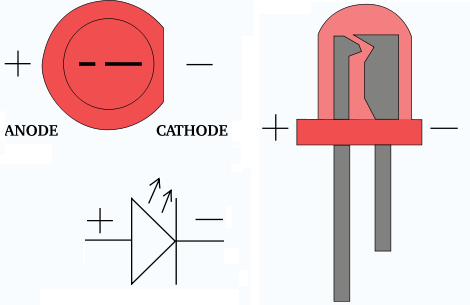
- An exception to this rule is that if you have a multi-color LED (two (tri-color) or three (RGB) LEDs in the same package are common) with a common-Cathode (all three Cathodes are tied together), then the Cathode is likely to be the long lead. Go figure. Also, be careful - I believe common-cathode rgb LEDs are more common, but I have seen common-anode rgb LEDs too!

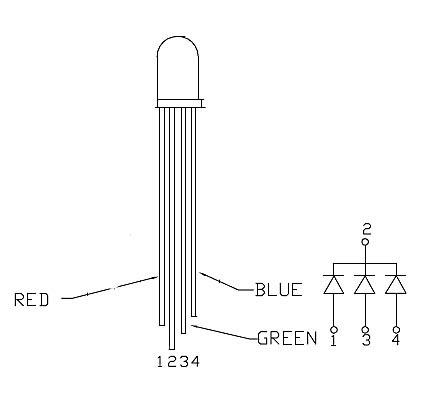
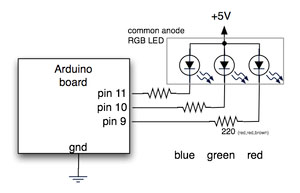
- LED forward voltage - this is the amount of voltage drop you see in an LED when it's on. Different LEDs will have different forward voltages (Vf). Here's what I measured for the LEDs we have in our class locker. If you buy your own, you need to pay attention to this parameter of the LEDs that you buy. It's an important part of the resistor calculation (see above).
| Vf |
5mm |
3mm |
| Red |
1.9v |
1.9v |
| White |
2.8v |
3.0v |
| Blue |
3.0v |
3.1v |
| Green |
2.1v |
2.1v |
| Orange |
1.95v |
1.95v |
- Resistor color code calculators - there are also lots of those out there. This one has a nice interface that lets you click on the color bands and shows you what the resistor's value is. This one let's you do that, but also you can put in a value and it will tell you what colors to look for. There are lots of others out there too.
- There are also lots of charts that show what the color code is. Here's one. Note that we will have four-band 5% resistors available (with gold as the fourth band).
- The Adruino is based on the AVR series of microcontrollers from Atmel. In particular, our board uses the AVR ATmega328p. If you're curious about the nitty gritty details of the controller, here is a 26 page summary, and a 488 page guide to that controller.
- Tod Kurt has some great tutorials on basic Arduino stuff:
- Bionic Arduino
- Spooky Arduino
- He also has info about Arduino programming of all sorts, how to turn a servo into a 360 degree grear motor, some LED that have an I2C interface, and other very useful sutff.
- Here's a document that lists mail order surplus and supply locations. This is from 2004, but most places should still be on-line in the same locations.
- Here's a small sample of local suppliers. Please send me suggestions for more names!
- Plastics (lexan, sintra, plexi, etc.): Regional Supply, 3571 South 300 West,
Salt Lake City, Utah 84115, phone 801-262-6451
- Electronics: Ra-ElCo - a cool electronics junk yard type store. All sorts of cool stuff. 2780 S Main St,
South Salt Lake, UT 84115,
801-487-7749
- Metal: Metal Supermarket, 537 West Pickett Circle,
Salt Lake City, UT 84115-2017,
Phone: (801) 972-5911
- Metal: Affiliated Metals, 450 N. Billy Mitchell Road, Salt Lake City, UT 84116 p: 801-363-1711
- Misc: University Surplus and Salvage - all sorts of stuff from all over the university, 210 Connor Street,
Salt Lake City, Utah 84113-5026,
(801) 581-7917 It's located in Ft. Douglas over by the Campus Recreation rental place.
Remaining topics to be covered.... (not yet assigned to specific days)
- Sensing examples
- resistive sensors (photocells, thermisters, flex sensors, pots)
- piezo sensors (vibration, debouncing)
- IR sensors (distance, movement)
- Sonar (rangefinders)
- Here's a great web site with reports about sensors of all kinds. Check out the Reports page for reports on a large variety of sensors, with code examples.
- Reading external signals
- debouncing
- reading pulses
- timing pulses
